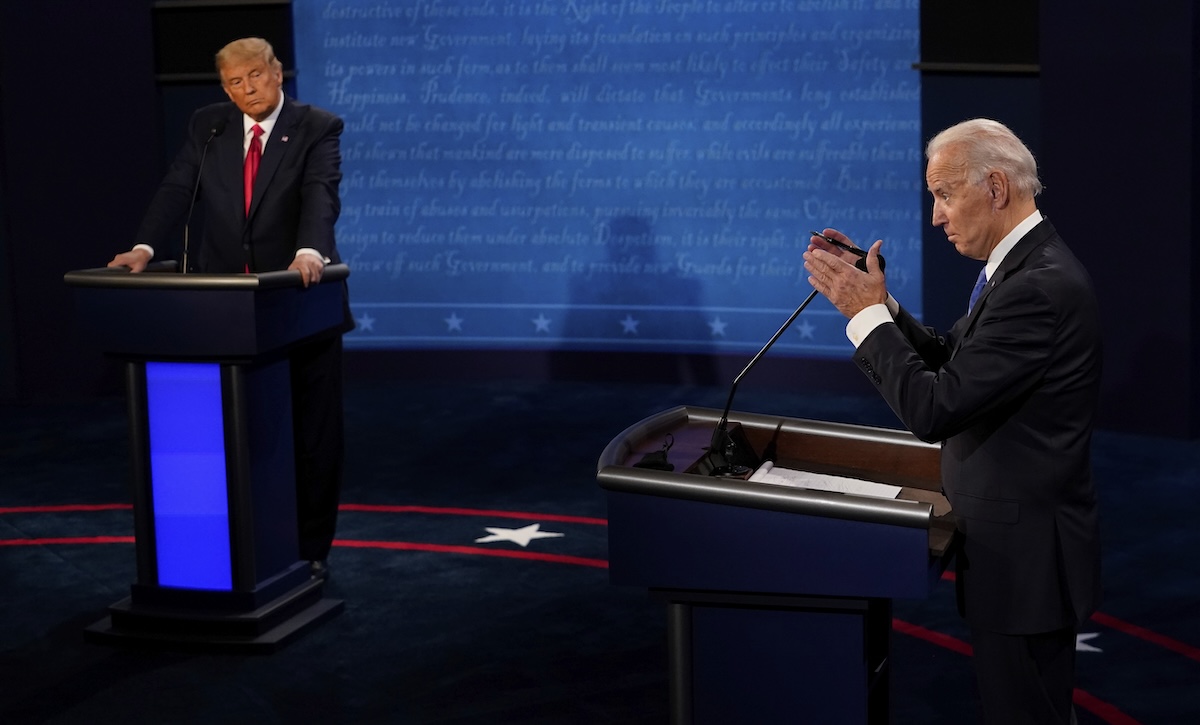In his latest book, Moral Vision: Leadership from George Washington to Joe Biden, Marvin Olasky, author of the highly influential Tragedy of American Compassion (and Acton affiliate scholar), examines American history in light of a Turkish saying, “the fish stinks first at the head,” meaning that moral decay at the highest echelons of society inevitably affects the whole. Toward this end, Moral Vision is composed of 18 portraits of influential Americans, mostly presidents, and describing how their private and inner lives affected their public leadership.
Olasky, as he states in his introduction, writes out of the conviction that “history is more than statistics, economics, and group identities. Human beings are more than paper boats riding the rainfall into gutters.” In his crosshairs is the idea of historical determinism, Marxian or otherwise—that is, the view that societies and civilizations rise and fall, prosper and disintegrate, according to impersonal economic forces. Olasky may have been influenced directly or indirectly by Russell Kirk, who had a similar idea in writing The Conservative Mind as a series of sketches of individual leaders as opposed to a treatise on conservative principles per se, to emphasize the influence of persons over impersonal forces.
One theme throughout the book is marital fidelity as a complement to such other virtues as sacrifice and selflessness. George Washington in particular, argues Olasky, made the revolution possible by his frequent displays of courageous and self-sacrificial behavior. One sixth of the American soldiers who wintered at Valley Forge over 1777–78 died, and those who did not desert must have seen something worth following in General Washington. But beyond his success on the battlefield, Washington was also consistently faithful to Martha for their entire marriage. Olasky makes the case throughout that there is an inseparable connection between marital fidelity and fidelity in other areas. In contrast to Washington’s faithfulness, Olasky emphasizes the infidelity of Redcoat generals Howe and Clinton, as well as of First Lord of the Admiralty Montagu, all of whom would have been more trustworthy and efficacious leaders had they upheld their marital vows. Olasky speaks with approbation about all his subjects who were, at least for the most part, committed to marital integrity. He applauds the uprightness of Grover Cleveland, Andrew Jackson, and Abraham Lincoln, who matched commitment to their wives with commitment to their ideals.
As a corollary, presidents whom Olasky finds politically lacking are also invariably unfaithful in marriage. Woodrow Wilson and FDR both earn criticism here, but Olasky is especially hard on JFK, probably the most adulterous president ever. The decline in American public morality in the 20th century seems to begin with Wilson, who in 1908 decided that his private affairs didn’t matter so long as he promoted “social reintegration” through government. From there it was not such a long slide to Kennedy’s believing he could commit adultery with reckless abandon, which in turn led Bill Clinton, for whom Kennedy was a personal hero, to believe his private actions would have no public consequences.
Olasky’s account of Kennedy is certainly the most negative of all the presidential profiles, save perhaps that of Jefferson, and maybe the most negative of Kennedy I’ve ever read. Though the author highlights JFK’s leadership during the Cuban Missile Crisis, he’s oddly negative about his wartime experience. Blaming Kennedy’s “poor maneuvering” for his PT boat’s being rammed on a moonless night by a Japanese destroyer, Olasky claims it was JFK’s father’s money that led the media to “cover up the incompetence” and instead spin Kennedy as a hero for saving his crew. Maybe the Japanese captain accomplished a deft maneuver by ramming the PT boat, but it doesn’t diminish the heroism displayed by the future president thereafter. Suffice to say, this is not generally how the 35th president’s military service is remembered.
Later, the author describes how Kennedy was wearing a back brace on the day of his assassination because he had hurt himself engaged in extramarital activities weeks before (as reported by Time magazine’s Hugh Sidey in 1987). Had he not worn it, the first bullet would have pushed him out of the way of the second, saving his life. This may be true, yet I wondered why Olasky didn’t mention how chronic back problems had afflicted Kennedy for decades and were exacerbated by his service in WWII, through which Kennedy frequently wore a back brace, not just following infidelity. The paragraph about Kennedy’s cheating indirectly contributing to his death is meant as a kind of moral lesson, but you really have to squint to see the connection.
Another theme pursued by Olasky is how statesmen of the early republic—Washington, Jefferson, Jackson, and Henry Clay—differed on their views and actions regarding slavery.
Thomas Jefferson, author of one of the most exquisite proclamations on human dignity ever, nevertheless ranks among America’s greatest hypocrites for his terrible (even for the time) racial views. While Washington was conflicted over owning slaves, and was a “fanboy” (Olasky’s phrase) of Phillis Wheatley, a famed 18th-century African American poet, Jefferson was contemptuous of Benjamin Banneker, another black poet who challenged the third president to live up to his own words. Not believing Benneker’s writing was his own, Jefferson said he must have used a white ghostwriter. While Washington saw slavery as a systematic evil from which he could not economically extricate himself, only freeing his slaves upon his death, Jefferson saw slavery as a necessary and fitting institution.
Clay at one time was ardently anti-slavery, writing in 1798, “Can any humane man be happy and contented when he sees … his fellow beings … deprived of all the rights which make life desirable, transferred like cattle from the possession of one another?” Yet, once it became clear that supporting abolition would end his political career, Clay dropped the subject. He was not a particularly kind slave owner either, as his escaped slaves attested, and did not free his slaves upon death. Jackson, in contrast, had no qualms about slavery, yet was careful to look after his own slaves, as evidenced by dismissing an unduly cruel white overseer. He also wrote a number of letters demanding that his overseers “treat my negroes with humanity” by not working them too hard and tending to them when sick.
While Jefferson’s animosity toward black people seems to warrant the harshest criticism, judging the other three statesmen quickly mires the reader in difficult questions about reading back into the past our current more enlightened stances. Washington, while displaying admiration for at least some blacks, was no abolitionist. And while Jackson exhibited no idealism about changing the world, he at least tried to be the most moral person he could while working within the power structures he uncritically inherited and inhabited.
Clay, though more morally aware than Jefferson and Jackson, was certainly hypocritical for acknowledging slavery as a great wrong but choosing power over privilege and basically setting the stage for the Civil War by constantly aiming for compromise between pro- and anti-slavery camps in Congress. Even so, Lincoln, in an oration about keeping Clay’s memory alive, called Clay his “beau ideal of a statesman,” so perhaps even those compromises counted for something positive.
One other theme that Olasky traces across the centuries is the centralization of political and economic power. While it was unsurprising to read generally negative descriptions of Woodrow Wilson and FDR as hallmarks of 20th century progressivism, Olasky’s views, which could be described as supportive of the subsidiarity principle, also influence his analysis of 19th-century politics. The Federalists and Whigs, who instituted tariffs to expand urbanization and manufacturing by protecting infant American industries from European competition, and who also supported chartering a Second Bank of the United States, are not cast favorably.
The idea of building America into an industrialized, urban nation is basically equated with a desire for a few centralized institutions to dominate American society through “patronage.” Instead of a combination of the free market and local and state institutions steering things, Washington-directed tariffs on foreign imports would boost some industries, effectively government clients, at the expense of others. And the Second Bank of the United States, shuttered by Andrew Jackson (who is lauded for doing so), was an institution analogous to what are today called development banks at the federal level for the purpose of financing infrastructure and other major projects too large for private or state institutions to take on. Was the Second Bank really so bad simply because it aggregated money from around the country to fund otherwise impossible projects in particular areas? Olasky thinks so, but he doesn’t so much argue this point as assume the reader’s agreement.
The final sections on Clinton vs. Gingrich and Biden vs. Trump round out Olasky’s tableau of principles in private and public, bringing America’s downward moral trajectory to the present. With the extramarital affairs of Clinton, Gingrich, and Trump, as well as the rhetorically confrontational styles of the latter two, all the necessary groundwork was laid for our present vulgarized era.
Biden, though less coarse than the others, exhibits a hypocrisy similar to that of Clay, but with abortion his issue, going from a moderate to an arch-defender as power pulled him. And while Trump’s presidency led to the overturning of Roe v. Wade, Olasky speculates that, because abortion is more a cultural than a legal debate, the 45th president and his pro-life supporters may have done more harm than good. Christian arguments in favor of Trump, especially from a “pragmatic” or “realist” standpoint, may prove not to have been realistic enough.
All in all, Moral Vision is an enjoyable and necessary contribution to the study of leadership, and a unique one at that for taking seriously the innermost worlds of some of America’s most influential public figures. Olasky makes his own views plain, but they never obscure his primary purpose. Having been closely involved in national politics in the 1990s, Olasky’s lament for what Clinton’s presidency could have achieved is particularly poignant. If there is to be a renewal of public morality in America, it will be led by writers like Olasky who illustrate the consequences of failing to define deviancy properly.

